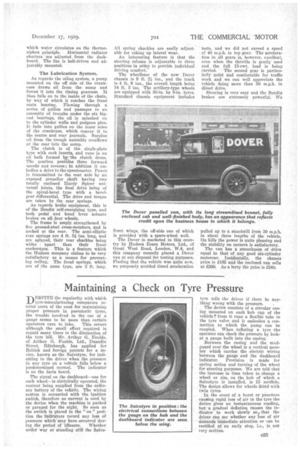An Entirely New LIGHT VAN Tried Out
Page 56

Page 57

If you've noticed an error in this article please click here to report it so we can fix it.
An Account of the Dover Six-cylinder 15-20-cwt. Van and of its Performance Under Load
J]'and Essex 1_1_ motorcars are famous in all the world's markets, and the recent appearance of the Dover light commercial chassis, which was seen at Olympia early this month, has strengthened the hands of all Hudson-Essex dealers. We have had the first opportunity for testing this machine on the road, and would like to give our readers an account of it.
Intepded for loads of from 15 to 20 cwt., the Dover Commercial Super-Six is equipped with a six-cylindered engine of 18.2 h.p. (R.A.C.)., its
design following orthodox lines. The engine, clutch and gearbox, con structed as a unit are mounted on rubber blocks at four points in. the deep, pressed-steel frame. The bore is 21 ins. and the stroke 41 ins., giving a capacity of 2,638 c.c. 're object of the dc signers has been (to use an Americanism) to damp Out engine vibration before it occurs.
To this end the Hudson patented crankshaft-balancing principle is employed, and it is claimed that this eliminates crankshaft whip and distortion at all speeds.
. The engine has three main crankshaft bearings. Side valves are used, the camshaft running in three largediameter bearings and being driven by a silent chain which is easily adjust able. The cylinder head is, of course, detachable. Rollertype tappets and split-skirt aluminium pistons are features worth mentioning. Auto-Lite lighting and starting equipment is provided, the chain drive to the camshaft also operating the dynamo.
The Marvel carburetter, mounted on the off side of the engine, has a pump-type acceleration device, and the induction is exhaust-jacketed, the quantity of exhaust gas circulating around the induction pipe being controlled by a by-pass valve which is interconneled with the throttle, so that at wider throttle opening • greater heat is applied to the incoming mixture. The by-pass can be adjusted to one of three positions, according to the climatic conditions in which the chassis is operating. An A.O. air, cleaner is fitted to the carburetter.
The cooling system comprises a large-capacity radiator, through which water circulates on the thermo siphen principle. Horizontal radiator shutters are adjusted from the dashboard. The fan is belt-driven and adjustably mounted.
The Lubrication System.
As regards the oiling system, a pump mounted on the off side of the crankcase draws oil from the sump and forces it into the timing gearcase. It thus falls on to the inside of the chain, by way of which it reaches the front main bearing. Flowing through a series of gullies and passages to an assembly of troughs under the six bigend bearings, the oil is splashed on to the cylinder walls and gudgeon pins. it falls into gullies on the inner sides of the crankcase, which convey it to the centre and rear journals. Surplus oil from the trough assembly overflows at the rear into the sump.
The clutch is of the single-plate type with cork inserts, and runs in an oil bath formed ily-the clutch drum. The gearbox provides three forward speeds and reverse; in addition it embodies a drive to the speedometer. Power is transmitted to the rear axle by an exposed propeller shaft having two totally enclosed Hardy Spicer universal joints, the final drive being of the spiral-bevel type with a bevelgear differential. The drive and torque are taken by the rear springs.
As regards brake equipment, this is of the Bent.lix self-energizing type, and both pedal and hand lever actuate brakes on all four wheels.
The frame is amply strengthened by five pressed-steel cross-members, and is arched at the rear. The semi-elliptic rear springs are 4 ft. 51 ins, long, and are splayed, their rear shackles being wider apart than their front anchorages. This is a feature which the Hudson company claims to be very satisfactory as a means for preventing rolling. The front springs, which are of the same type, are 3 ft. long.
All spring shackles are easily adjustable for taking up lateral wear.
An interesting feature is that the steering column is adjustable to three positions in order to provide individual driving comfort.'
The wheelbase of the new Dover chassis is 9 ft. n ins., and the track is 4 ft. 9 ins., the overall length being 14 ft. 3 ins. The artillery-type wheels are equipped with 30-in. by 5-in. tyres. Standard chassis equipment includes
front wings, the off-side one of which is provided with a spare-wheel well.
The Dover is marketed in this country by Hudson Essex Motors, Ltd., of Great West Road, London, W.4, and this company recently placed a Dover van at our disposal for testing purposes.. Finding that the vehicle was quite new, we purposely avoided timed acceleration
tests, and we did not exceed a speed of 40 m.p.h. in top gear. The acceleration in all gears is, however, excellent, even when the throttle is gently used and the full 15-cwt. load is being Carried. The second gear is particularly quiet and comfortable for traffic work and we can well appreciate the vehicle doing more than 50 m.p.h. in direct drive.
Steering is very easy and the Bendix brakes are extremely powerful. We pulled up to a standstill from 30 m.p.h. in about three lengths of the vehicle. On hills the power is quite pleasing and the stability on corners is satisfactory.
The van has a smoothness of drive equal to that of any good six-cylinder motorcar. Incidentally, the chassis price is £185 and the enclosed van sells at £260. As a lorry the price is 4240.












































































































